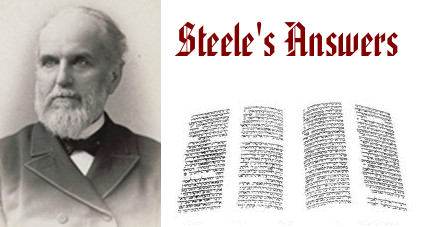"And if his oblation be a sacrifice of peace offering, if he offer it of the herd; whether it be a male or female, he shall offer it without blemish before the LORD. And he shall lay his hand upon the head of his offering, and kill it at the door of the tabernacle of the congregation: and Aaron’s sons the priests shall sprinkle the blood upon the altar round about. And he shall offer of the sacrifice of the peace offering an offering made by fire unto the LORD; the fat that covereth the inwards, and all the fat that is upon the inwards, And the two kidneys, and the fat that is on them, which is by the flanks, and the caul above the liver, with the kidneys, it shall he take away. And Aaron’s sons shall burn it on the altar upon the burnt sacrifice, which is upon the wood that is on the fire: it is an offering made by fire, of a sweet savour unto the LORD." — Leviticus 3:1`-6 KJV.
THE PEACE OFFERING.
1. Sacrifice of peace offering — Although this is not spoken of till after the giving of the decalogue, Exodus 20:24, the manner of the mention then made implies that it was a customary offering. Hence we have styled it traditional. It is chiefly eucharistic, with the subordinate notion of propitiation, as will be seen in the laying of the hand upon the victim and in the sprinkling of the blood. Hence the Seventy render it θυσία σωτηρίου, “a sacrifice of salvation,” implying that it restores peace. But since no distinct reference is made to sin or to its priestly atonement, as in the sin offering, (Leviticus 4:20,) we have called it a thanksgiving offering of one in the enjoyment of the peace afforded by a clear conscience. This is corroborated by the fact that it was to be eaten by the offerer and his friends in a festive banquet. It was the vehicle of communion with Jehovah and with those who feared his name.
Of the herd — See note on chap. 1:2.
Male or female — The whole burnt offering, the type of Christ, was a male victim. Without blemish — See note on Leviticus 1:3.
2. Hand… head — This impressive ceremony links the victim to the offerer, and at the same time shows his relinquishment of all claim, and his devotion of the animal to Jehovah. See note on Leviticus 1:4.
Blood upon the altar — The sprinkling of blood seems to have been the very core of the sacrificial system. For the office of the blood, see The Ceremonial Function of the Blood.
3. The fat — The suet or sweet fat is here described. The fat diffused through the flesh it was lawful to eat. The suet was forbidden food. Leviticus 7:23. The burning of the suet is particularly specified in every kind of offering of a victim. Whatever was reserved for the priest, or to the offerer, the suet must always be burned. The reason may be, because this is the best portion. Murphy assigns another reason: “The fat is expressive of the holiness which pertains to the Substitute, as the blood is significant of the penal death which He has undertaken to suffer. The two go to make up what is called righteousness, or active and passive obedience to the law for the sinner.” We see no semblance between fat and holiness which can make one a fitting type of the other except their purity and unmingled nature. See Concluding Note.
4. The two kidneys — Professor Bush suggests that the kidneys were burned because they are “the supposed seat of some of the strongest sensual propensities,” such as fornication and uncleanness. But we fail to see why the kidneys should be burned for this reason while the very organs of impurity are spared. The kidneys (reins) are, with the Scripture writers, the inmost seat of character. Their burning signifies the purgation, by the fire of the Holy Spirit, of the inscrutable depths of the spiritual nature and the cleansing of the heart from inbred sin. “God trieth the hearts and kidneys.” Psalm 7:9. “I try the kidneys.” Jeremiah 17:10. Outside of the Pentateuch the substitution of reins for kidneys occurs in the Authorized Version thirteen times in the Old Testament.
The caul above the liver — These words are found together twice in Exodus, and quite often in the sacrificial ritual of Leviticus. In physiological terms it is “the small omentum which bounds part of the liver and the stomach, and comes into the region of the kidneys, and which is itself surrounded with the tunica adiposa — a bed of fatty matter.”


No comments:
Post a Comment